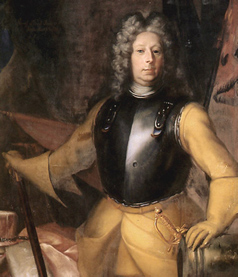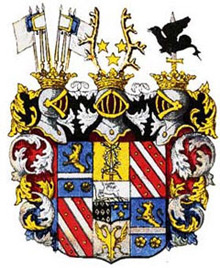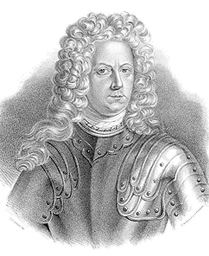|
 Count Carl Gustav Rehnsköld (1651-1722), Field Marshal, was one of Charles XII's most gifted
commanders. He was born Carl Kewenbringk in Greifswald (Germany), son of Gerdt Antoniison Kewenbringk, commissioner of land revenue and later state councilor.
After being raised to the rank of nobility in 1639 Kewenbringk adopted the last name Rehnsköld. Carl Rehnsköld graduated from the University of Lund where
he studied under the guidance of Samuel Pufendorf, the famous German lawyer, historian and philosopher. In 1673 he started military service in the Närke-Värmland
regiment as a fänrik (second lieutenant). Three years later he was promoted to lieutenant of the guard. During the Swedish-Danish war (1676-1679) Karl Rehnsköld
showed great courage in the battles of Halmstad (1675), Lund (1676) and Landskrona (1677). As a result, in 1677 he was promoted to lieutenant colonel of the Queen's
Mounted Life Guard Regiment at the age of only 26. When the war was over he took an active part in the reorganization of the Swedish military settlement system
(indelningverket).
Count Carl Gustav Rehnsköld (1651-1722), Field Marshal, was one of Charles XII's most gifted
commanders. He was born Carl Kewenbringk in Greifswald (Germany), son of Gerdt Antoniison Kewenbringk, commissioner of land revenue and later state councilor.
After being raised to the rank of nobility in 1639 Kewenbringk adopted the last name Rehnsköld. Carl Rehnsköld graduated from the University of Lund where
he studied under the guidance of Samuel Pufendorf, the famous German lawyer, historian and philosopher. In 1673 he started military service in the Närke-Värmland
regiment as a fänrik (second lieutenant). Three years later he was promoted to lieutenant of the guard. During the Swedish-Danish war (1676-1679) Karl Rehnsköld
showed great courage in the battles of Halmstad (1675), Lund (1676) and Landskrona (1677). As a result, in 1677 he was promoted to lieutenant colonel of the Queen's
Mounted Life Guard Regiment at the age of only 26. When the war was over he took an active part in the reorganization of the Swedish military settlement system
(indelningverket).
 In 1691 he decided to continue his military career in the Dutch army. Rehnsköld participated in the Dutch-French war of 1688-1697. In May 1693 he
joined the Swedish army and soon was given the rank of lieutenant colonel of the Northern Skania Cavalry Regiment. At the beginning of the Great Northern War he was
raised to the rank of nobility, promoted to Lieutenant General of the Cavalry, and appointed Governor of Skåne (1698). Highlights of his career include a highly successful
campaign against Poland from 1701-1703. He commanded the Swedish forces in the Battle of Fraustadt (1706). The Swedish success in this battle was due mainly to
Rehnsköld having effectively neutralized the Saxon infantry. Although the Saxons were superior in numbers at the start of the battle, the Swedish cavalry succeeded
in performing a double envelopment. In the end 7,600 Saxons were taken prisoner and over 7,000 were killed in battle. The Swedes suffered some 400 killed and 760
wounded. Fraustadt also gave Rehnsköld a reputation for ruthlessness after he ordered the execution of all Russian prisoners after the battle. Already General of the
Cavalry, after this battle he was promoted to Field Marshal, and made Count and Royal Councilor. During the Russian campaign of Charles XII he led the cavalry in the battle
of Holowczyn (1708) and contributed significantly to the Swedish victory over the Russians. Carl Rehnsköld participated in the Swedish assault on the Ukrainian fortress
of Veprik in January 1709.
In 1691 he decided to continue his military career in the Dutch army. Rehnsköld participated in the Dutch-French war of 1688-1697. In May 1693 he
joined the Swedish army and soon was given the rank of lieutenant colonel of the Northern Skania Cavalry Regiment. At the beginning of the Great Northern War he was
raised to the rank of nobility, promoted to Lieutenant General of the Cavalry, and appointed Governor of Skåne (1698). Highlights of his career include a highly successful
campaign against Poland from 1701-1703. He commanded the Swedish forces in the Battle of Fraustadt (1706). The Swedish success in this battle was due mainly to
Rehnsköld having effectively neutralized the Saxon infantry. Although the Saxons were superior in numbers at the start of the battle, the Swedish cavalry succeeded
in performing a double envelopment. In the end 7,600 Saxons were taken prisoner and over 7,000 were killed in battle. The Swedes suffered some 400 killed and 760
wounded. Fraustadt also gave Rehnsköld a reputation for ruthlessness after he ordered the execution of all Russian prisoners after the battle. Already General of the
Cavalry, after this battle he was promoted to Field Marshal, and made Count and Royal Councilor. During the Russian campaign of Charles XII he led the cavalry in the battle
of Holowczyn (1708) and contributed significantly to the Swedish victory over the Russians. Carl Rehnsköld participated in the Swedish assault on the Ukrainian fortress
of Veprik in January 1709.
 The Swedes surrounded the town and then attacked with two infantry and three cavalry regiments with artillery. The assault on Veprik cost the
Swedes over 1,200 men killed and wounded because the Swedes were unable to execute a simultaneous attack by the infantry and the cavalry columns. The wounded included
Prince Wirtenburg, General Stackelberg, and Field Marshal Rehnsköld, who received a concussion. When Charles XII was incapacitated by a wound just before the
Battle of Poltava (1709), he appointed Rehnsköld commander in chief. The battle was a disaster for the hopelessly outnumbered Swedes; Rehnsköld himself was
captured by the Russians. In 1718 he was released in exchange for the Russian general Avtonom Golovin who had been captured during the Battle of Narva in 1700. In the
same year Rehnsköld accompanied Charles XII in his last campaign against Norway. In 1719 Rehnsköld became Supreme Commander of Skåne and a
member of the Royal Council. In January 1722 he fell ill during a trip to Kungsör castle, and died on January 29, 1722 in Läggesta.
The Swedes surrounded the town and then attacked with two infantry and three cavalry regiments with artillery. The assault on Veprik cost the
Swedes over 1,200 men killed and wounded because the Swedes were unable to execute a simultaneous attack by the infantry and the cavalry columns. The wounded included
Prince Wirtenburg, General Stackelberg, and Field Marshal Rehnsköld, who received a concussion. When Charles XII was incapacitated by a wound just before the
Battle of Poltava (1709), he appointed Rehnsköld commander in chief. The battle was a disaster for the hopelessly outnumbered Swedes; Rehnsköld himself was
captured by the Russians. In 1718 he was released in exchange for the Russian general Avtonom Golovin who had been captured during the Battle of Narva in 1700. In the
same year Rehnsköld accompanied Charles XII in his last campaign against Norway. In 1719 Rehnsköld became Supreme Commander of Skåne and a
member of the Royal Council. In January 1722 he fell ill during a trip to Kungsör castle, and died on January 29, 1722 in Läggesta.
|
 History
History
 Dates and events
Dates and events
 Persons
Persons
 Poltava
Poltava
 Sights
Sights
 Photo gallery
Photo gallery
 Maps
Maps
 Virtual Museum
Virtual Museum
 Armament
Armament
 Uniforms
Uniforms
 Coins and medals
Coins and medals
 Flags
Flags
 Paintings
Paintings
 Poltava photographs
Poltava photographs
 News
News
 About us
About us
 Acknowledgments
Acknowledgments
 Main page
Main page
 top
top ...back
...back  History
History
 Dates and events
Dates and events
 Persons
Persons
 Poltava
Poltava
 Sights
Sights
 Photo gallery
Photo gallery
 Maps
Maps
 Virtual Museum
Virtual Museum
 Armament
Armament
 Uniforms
Uniforms
 Coins and medals
Coins and medals
 Flags
Flags
 Paintings
Paintings
 Poltava photographs
Poltava photographs
 News
News
 About us
About us
 Acknowledgments
Acknowledgments
 Main page
Main page